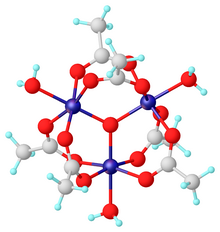Chromium(III) acetate

| |

| |
| Names | |
|---|---|
| IUPAC name
Chromium(III) acetate hydrate
| |
| Other names
chromic acetate,
chromium triacetate, chromium(III) ethanoate | |
| Identifiers | |
3D model (
JSmol ) |
|
| ChemSpider | |
ECHA InfoCard
|
100.012.646 |
PubChem CID
|
|
CompTox Dashboard (EPA)
|
|
| |
| |
| Properties | |
| C12H36ClCr3O22 | |
| Molar mass | 723.84 g·mol−1 |
| Appearance | grayish-green to blueish-green solid |
| Density | 1.662 g/cm3 |
| Melting point | 1,152[1] °C (2,106 °F; 1,425 K) |
| -5104.0·10−6 cm3/mol | |
| Structure | |
| octahedral | |
| Related compounds | |
Related compounds
|
Manganese(III) acetate Iron(III) acetate |
Except where otherwise noted, data are given for materials in their standard state (at 25 °C [77 °F], 100 kPa).
| |
Chromium(III) acetate, commonly known as basic chromium acetate,[2] describes a family of salts where the cation has the formula [Cr3O(O2CCH3)6(OH2)3]+. The trichromium cation is encountered with a variety of anions, such as chloride and nitrate. Data in the table above are for the chloride hexahydrate, [Cr3O(O2CCH3)6(OH2)3]Cl(H2O)6.
basic iron acetate
is isostructural with the cation in basic chromium acetate. Both feature octahedral metal centers conjoined by oxo and acetate bridging ligands.Salts of basic chromium acetate has long attracted interest because of its distinctive structure, which features octahedral Cr(III) centers, a triply bridging
oxo ligand.[4] Chromium(III) acetate is a blue/grey-green powder, which is soluble in water. It is still[3] prepared according to the original procedure from 1909.[5]
See also
References
- ^ "Chromium (III) compounds". National Pollutant Inventory. Australian Government Department of Agriculture, Water and the Environment. Retrieved 14 April 2021.
- ^ ISBN 978-0-08-037941-8.
- ^ .
- .
- .
